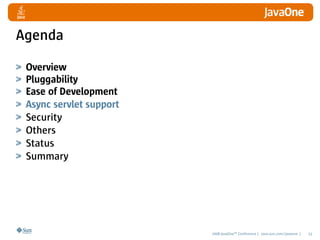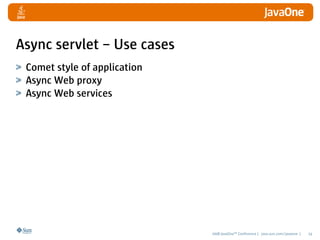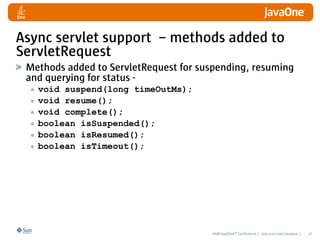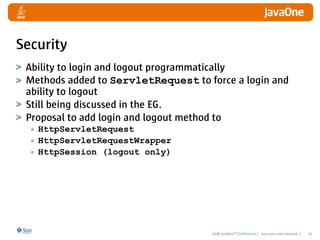Introduction to java servlet 3.0 api javaone 2008
- 1. Java™ Servlet 3.0 API: What's new and exciting Rajiv Mordani Senior Staff Engineer, Sun Microsystems TS-5415
- 2. Learn about the new features in the Java™ Servlet 3.0 API 2008 JavaOneSM Conference | java.sun.com/javaone | 2
- 3. Agenda Overview Pluggability Ease of Development Async servlet support Security Others Status Summary 2008 JavaOneSM Conference | java.sun.com/javaone | 3
- 4. Overview Java™ Servlet 3.0 API – JSR 315 Has about 20 members in the expert group with a good mix of representation from the major Java™ EE vendors, web container vendors and individual web framework authors Main areas of improvements and additions are - • Pluggability • Ease of development • Async servlet support • Security enhancements Note: Specification in early draft and things can change • The good news is that the community still has time to provide feedback 2008 JavaOneSM Conference | java.sun.com/javaone | 4
- 5. Agenda Overview Pluggability Ease of Development Async servlet support Security Others Status Summary 2008 JavaOneSM Conference | java.sun.com/javaone | 5
- 6. Pluggability Make it possible to use framework and libraries with no additional configuration Modularizing web.xml to allow frameworks / libraries to have their own entities defined and self-contained within the framework Adding APIs to ServletContext to allow addition of Servlets, Filters and Listeners to a web application at application startup time. Use of annotations to declare all the components within a web application 2008 JavaOneSM Conference | java.sun.com/javaone | 6
- 7. Pluggability - Modularization of web.xml Current users of framework need to edit their application's web.xml to • Define a Java™ Servlet provided by the framework (typically a controller Java™ Servlet ) • Define Filters that the framework needs in order to be used within a web application (logging for example or Filters to implement security constraints) • Define listeners so that appropriate action can be taken at different points in the application / component's life cycle. Monolithic web.xml can become complex to maintain as the dependencies of the application increases Each framework needs to document for the developer what all must be declared in the web.xml 2008 JavaOneSM Conference | java.sun.com/javaone | 7
- 8. Pluggability – Modularization of web.xml Java™ Servlet 3.0 specification introduces the concept of modular web.xml Each framework can define it's own web.xml and include it in the jar file's META-INF directory The developer needs to include the framework jar in the application At deployment the container is responsible for discovering the web.xml fragments and processing them. Introduce new element – web-fragment that can define servlets, filters and listeners as child elements. 2008 JavaOneSM Conference | java.sun.com/javaone | 8
- 9. Pluggability - example new elements in web.xml <web-fragment> <servlet> <servlet-name>welcome</servlet-name> <servlet-class> WelcomeServlet </servlet-class> </servlet> <servlet-mapping> <servlet-name>welcome</servlet-name> <url-pattern>/Welcome</url-pattern> </servlet-mapping> ... </web-fragment> 2008 JavaOneSM Conference | java.sun.com/javaone | 9
- 10. Pluggability – Configuration methods in ServletContext In addition to web.xml modularization methods added to the ServletContext to declare and configure servlets and filters. Can only be called at context initialization time. Allows to • Declare a new Servlet • Define a url mapping for the Servlet declared • Declare a Filter • Define a url mapping for the Filter Enables applications to load Servlets and filters at runtime that are needed 2008 JavaOneSM Conference | java.sun.com/javaone | 10
- 11. Pluggability – APIs in ServletContext example @ServletContextListener public class MyListener { public void contextInitialized (ServletContextEvent sce) { ServletContext sc = sce.getServletContext(); sc.addServlet("myServlet", "Sample servlet", "foo.bar.MyServlet", null, -1); sc.addServletMapping("myServlet", new String[] {"/urlpattern/*"}); } } 2008 JavaOneSM Conference | java.sun.com/javaone | 11
- 12. Pluggability – APIs in ServletContext example @ServletContextListener public class MyListener { public void contextInitialized (ServletContextEvent sce) { ServletContext sc = sce.getServletContext(); sc.addFilter("myFilter", "Sample Filter", "foo.bar.MyFilter", null); sc.addFilterMapping("myFilter", new String[] {"/urlpattern/*"}, “myServlet”, DispatcherType.REQUEST, false); } } 2008 JavaOneSM Conference | java.sun.com/javaone | 12
- 13. Agenda Overview Pluggability Ease of Development Async servlet support Security Others Status Summary 2008 JavaOneSM Conference | java.sun.com/javaone | 13
- 14. Ease of Development Focus on ease of development in Java™ Servlet 3.0 API Enhance Java™ Servlet APIs to use newer language features Annotations for declarative style of programming Generics for better compile time error checking and type safety web.xml optional (was already optional for Java™ EE 5) • Restricted to JSPs and static resources only Better defaults / convention over configuration 2008 JavaOneSM Conference | java.sun.com/javaone | 14
- 15. Ease of Development – defining a servlet Define a servlet using a @Servlet annotation Must contain a url-mapping All other fields optional with reasonable defaults – • example the “name” of the servlet is the fully qualified class name if none is specified. • Can define the appropriate http methods using the annotations @GET, @PUT, @POST, @DELETE, @HEAD • @HttpMethod meta-annotation allows extensions Can use the web.xml to override annotation values 2008 JavaOneSM Conference | java.sun.com/javaone | 15
- 16. Servlet example – 2.5 style web.xml public class SimpleSample <web-app> extends HttpServlet { <servlet> <servlet-name> public void doGet MyServlet (HttpServletRequest req, </servlet-name> HttpServletResponse res) <servlet-class> { samples.SimpleSample </servlet-class> </servlet> } <servlet-mapping> } <servlet-name> MyServlet </servlet-name> <url-pattern> /MyApp </url-pattern> </servlet-mapping> ... </web-app> 2008 JavaOneSM Conference | java.sun.com/javaone | 16
- 17. Ease of development – Defining a servlet @Servlet(urlMapping={“/foo”}) public class SimpleSample { } 2008 JavaOneSM Conference | java.sun.com/javaone | 17
- 18. Code Sample @Servlet(urlMapping={“/foo”, “/bar”}, name=”MyServlet”) public class SampleUsingAnnotationAttributes { @GET public void handleGet(HttpServletRequest req, HttpServletResponse res) { } } 2008 JavaOneSM Conference | java.sun.com/javaone | 18
- 19. Ease of development – Defining a Filter Define a Filter using a @ServletFilter annotation Must contain a @FilterMapping annotation All other fields optional with reasonable defaults 2008 JavaOneSM Conference | java.sun.com/javaone | 19
- 20. Code Sample package samples; import javax.servlet.http.annotation.*; @ServletFilter @FilterMapping(urlPattern=”/foo”) public class SampleFilter { public void doFilter(HttpServletRequest req, HttpServletResponse res) { } } 2008 JavaOneSM Conference | java.sun.com/javaone | 20
- 21. Ease of development – Defining a ServletContextListener Define a context listener using a @ServletContextListener annotation 2008 JavaOneSM Conference | java.sun.com/javaone | 21
- 22. Ease of Developmnt – ServletContext example @ServletContextListener public class MyListener { public void contextInitialized (ServletContextEvent sce) { ServletContext sc = sce.getServletContext(); sc.addServlet("myServlet", "Sample servlet", "foo.bar.MyServlet", null, -1); sc.addServletMapping("myServlet", new String[] {"/urlpattern/*"}); } } 2008 JavaOneSM Conference | java.sun.com/javaone | 22
- 23. Agenda Overview Pluggability Ease of Development Async servlet support Security Others Status Summary 2008 JavaOneSM Conference | java.sun.com/javaone | 23
- 24. Async servlet – Use cases Comet style of application Async Web proxy Async Web services 2008 JavaOneSM Conference | java.sun.com/javaone | 24
- 25. Async servlet support – popular use case Comet Primer • Rely on a persistent HTTP connection between server and client • Two strategies • Streaming - browser opens a single persistent connection to the server for all Comet events each time the server sends a new event, the browser interprets it. • Long polling - a new request for each event (or set of events) • Standardization efforts as part of the Bayeux protocol Implementation specific APIs available today in the various Java™ Servlet containers. APIs added to Java™ Servlet 3.0 specification to enable Comet style programming Request can be suspended and resumed 2008 JavaOneSM Conference | java.sun.com/javaone | 25
- 26. Async servlet support - Suspending a request Request can be suspended by the application Allows the container to not block on a request that needs access to a resource – for example access to a DataSource or wait for a response from a call to a WebService. When resumed the Request is re-dispatched through the filters for processing. • Results in an additional thread for handling the new request The resume method on the request resumes processing • Can be used to push timely events in multi-user applications The complete method to indicate the completion of request processing Can query if a request is suspended, resumed or has timed out. 2008 JavaOneSM Conference | java.sun.com/javaone | 26
- 27. Async servlet support – methods added to ServletRequest Methods added to ServletRequest for suspending, resuming and querying for status - • void suspend(long timeOutMs); • void resume(); • void complete(); • boolean isSuspended(); • boolean isResumed(); • boolean isTimeout(); 2008 JavaOneSM Conference | java.sun.com/javaone | 27
- 28. Async servlet support – Events on RequestListener Corresponding events fired for changes to request processing. Notification for suspend, resume and complete available for developers via the ServletRequestListener Methods added to ServletRequestListener • void requestSuspended(ServletRequestEvent rre); • void requestResumed(ServletRequestEvent rre); • void requestCompleted(ServletRequestEvent rre); 2008 JavaOneSM Conference | java.sun.com/javaone | 28
- 29. Async servlet support – methods added to Response Methods added to ServletResponse for disabling, enabling and querying for status - • void disable(); • void isDisabled(); • void enable(); 2008 JavaOneSM Conference | java.sun.com/javaone | 29
- 30. Async servlet to web services call 2008 JavaOneSM Conference | java.sun.com/javaone | 30
- 31. Agenda Overview Pluggability Ease of Development Async servlet support Security Others Status Summary 2008 JavaOneSM Conference | java.sun.com/javaone | 31
- 32. Security Ability to login and logout programmatically Methods added to ServletRequest to force a login and ability to logout Still being discussed in the EG. Proposal to add login and logout method to • HttpServletRequest • HttpServletRequestWrapper • HttpSession (logout only) 2008 JavaOneSM Conference | java.sun.com/javaone | 32
- 33. Security – login and logout Login method intended to allow an application or framework to force a container mediated authentication from within an unconstrained request context Login requires access to the HttpResponse object to set the www-authenticate header. • Available through new methods added to the request to give access to the corresponding response object logout methods are provided to allow an application to reset the authentication state of a request without requiring that authentication be bound to an HttpSession Still in discussion in the Expert Group and not closed upon. 2008 JavaOneSM Conference | java.sun.com/javaone | 33
- 34. Agenda Overview Pluggability Ease of Development Async servlet support Security Others Status Summary 2008 JavaOneSM Conference | java.sun.com/javaone | 34
- 35. Others – HttpOnly Cookie support Added support for HttpOnlyCookies Prevents access to the cookie from client side scripting code Prevents cross-site scripting attacks. Method added to Cookie to set and query if it is an HttpOnly cookie 2008 JavaOneSM Conference | java.sun.com/javaone | 35
- 36. Others – Session tracking cookie configuration Ability to set the session tracking cookie configuration for the corresponding ServletContext Supports multiple Session tracking mode – COOKIE, URL, SSL 2008 JavaOneSM Conference | java.sun.com/javaone | 36
- 37. Pending discussion in the expert group Miscellaneous items to be done for Java™ Servlet 3.0 API • File upload • Container wide init-params • Clarifications from previous releases • Enablement of JAX-RS / JSF 2.0 (if any changes needed) 2008 JavaOneSM Conference | java.sun.com/javaone | 37
- 38. Java EE profiles Java EE 6 specification introducing notion of profiles Targeting a web profile for Java EE 6 Web profile to be based on Servlets and JSPs Still being discussed in the Java EE 6 expert group Roberto solicited feedback from the community Varying opinions of what should be in the profile Still need to close on in the Java EE 6 expert group 2008 JavaOneSM Conference | java.sun.com/javaone | 38
- 39. Web/EJB Technology Application in JavaTM EE Platform 5 foo.ear foo.ear lib/foo_common.jar foo_web.war WEB-INF/web.xml com/acme/Foo.class WEB-INF/classes/ com/acme/FooServlet.class foo_web.war WEB-INF/classes com/acme/Foo.class OR WEB-INF/web.xml WEB-INF/classes/ com/acme/FooServlet.class foo_ejb.jar com/acme/FooBean.class foo_ejb.jar com/acme/Foo.class com/acme/FooBean.class 2008 JavaOneSM Conference | java.sun.com/javaone | 39
- 40. Web/EJB Technology Application in JavaTM EE Platform 6 foo.war WEB-INF/classes/ com/acme/FooServlet.class WEB-INF/classes/ com/acme/FooBean.class 2008 JavaOneSM Conference | java.sun.com/javaone | 40
- 41. EJB in a WAR file Goal is to remove an artificial packaging restriction • NOT to create a new flavor of EJB component EJB component behavior is independent of packaging Full EJB container functionality available 2008 JavaOneSM Conference | java.sun.com/javaone | 41
- 42. Agenda Overview Pluggability Ease of Development Comet Security Status Summary 2008 JavaOneSM Conference | java.sun.com/javaone | 42
- 43. Status Currently in Early Draft Review Public Review in summer of this year Proposed final draft and final release aligned with Java™ EE 6 Early access to bits of implementation to be available via Project GlassFish 2008 JavaOneSM Conference | java.sun.com/javaone | 43
- 44. Agenda Overview Pluggability Ease of Development Comet Security Status Summary 2008 JavaOneSM Conference | java.sun.com/javaone | 44
- 45. Summary Lot of exciting things happening in the Java™ Servlet 3.0 API • Pluggability for frameworks • Ease of Development for developers • Comet support to enable modern web 2.0 style applications • Security enhancements to enable programmatic login / logout • Miscellaneous improvements for better developer experience Make the life of framework developers and users much easier Implementation being done in open source as part of GlassFish project 2008 JavaOneSM Conference | java.sun.com/javaone | 45
- 46. GlassFish Community Open Source, Enterprise Ready & Extendable •GlassFish V3 Tech Preview 2 Available now! • GlassFish Partner Initiative •Modular OSGi architecture – easy to deploy, Develop and Extend •Expanding the ecosystem for •GlassFish V2 – Production Ready partners. ● Fastest open source app server with • Enterprise and Mission Critical Clustering, High Availability, Load Balancing Support sun.com/software/products/appsrvr ● Support for jMaki, Comet, Ajax, Ruby and • GlassFish Unlimited Pricing Groovy •GlassFish ESB •Fixed price, unlimited ● Core SOA functions now embedded in deployments GlassFish •Combine w/ MySQL Unlimited •GlassFish Communications App Server • Tools Integration ● SIP servlet technology for converged •NetBeans and Eclipse services glassfish.org Always free to download, deploy and distribute 2008 JavaOneSM Conference | java.com.sun/javaone | 46
- 47. For More Information Official JSR Page • http://jcp.org/en/jsr/detail?id=315 JAX-RS – TS 5425 JSF 2.0 – TS 5979 Mailing list for webtier related issues - webtier@glassfish.dev.java.net Rajiv's blog • http://weblogs.java.net/blog/mode 2008 JavaOneSM Conference | java.sun.com/javaone | 47
- 48. Rajiv Mordani Senior Staff Engineer, Sun Microsystems TS-5415 2008 JavaOneSM Conference | java.sun.com/javaone | 48





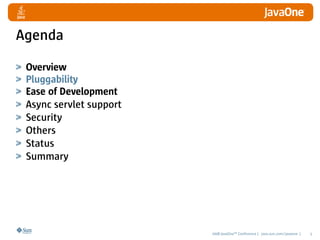
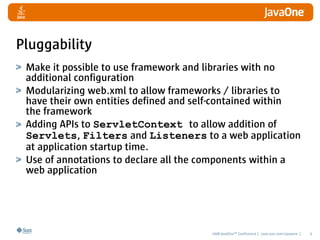

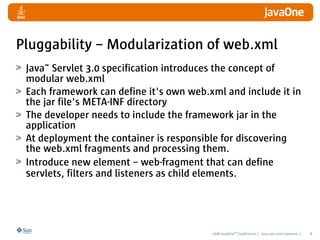


![Pluggability – APIs in ServletContext example
@ServletContextListener
public class MyListener {
public void contextInitialized
(ServletContextEvent sce) {
ServletContext sc = sce.getServletContext();
sc.addServlet("myServlet",
"Sample servlet",
"foo.bar.MyServlet",
null, -1);
sc.addServletMapping("myServlet",
new String[]
{"/urlpattern/*"});
}
}
2008 JavaOneSM Conference | java.sun.com/javaone | 11](https://image.slidesharecdn.com/introductiontojavaservlet3-0apijavaone2008-100520102435-phpapp02/85/Introduction-to-java-servlet-3-0-api-javaone-2008-11-320.jpg)
![Pluggability – APIs in ServletContext example
@ServletContextListener
public class MyListener {
public void contextInitialized
(ServletContextEvent sce) {
ServletContext sc = sce.getServletContext();
sc.addFilter("myFilter",
"Sample Filter",
"foo.bar.MyFilter",
null);
sc.addFilterMapping("myFilter",
new String[]
{"/urlpattern/*"},
“myServlet”,
DispatcherType.REQUEST,
false);
}
}
2008 JavaOneSM Conference | java.sun.com/javaone | 12](https://image.slidesharecdn.com/introductiontojavaservlet3-0apijavaone2008-100520102435-phpapp02/85/Introduction-to-java-servlet-3-0-api-javaone-2008-12-320.jpg)
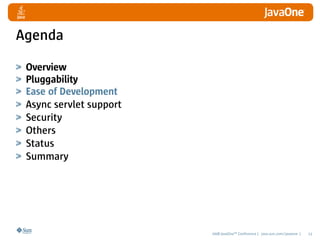

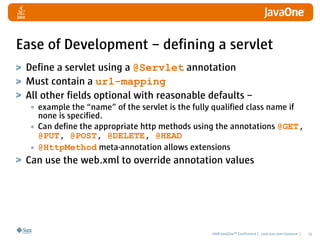


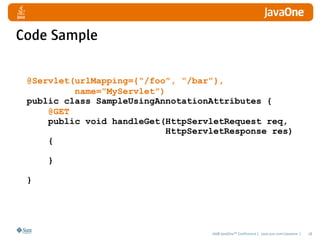



![Ease of Developmnt – ServletContext
example
@ServletContextListener
public class MyListener {
public void contextInitialized
(ServletContextEvent sce) {
ServletContext sc = sce.getServletContext();
sc.addServlet("myServlet",
"Sample servlet",
"foo.bar.MyServlet",
null, -1);
sc.addServletMapping("myServlet",
new String[]
{"/urlpattern/*"});
}
}
2008 JavaOneSM Conference | java.sun.com/javaone | 22](https://image.slidesharecdn.com/introductiontojavaservlet3-0apijavaone2008-100520102435-phpapp02/85/Introduction-to-java-servlet-3-0-api-javaone-2008-22-320.jpg)
